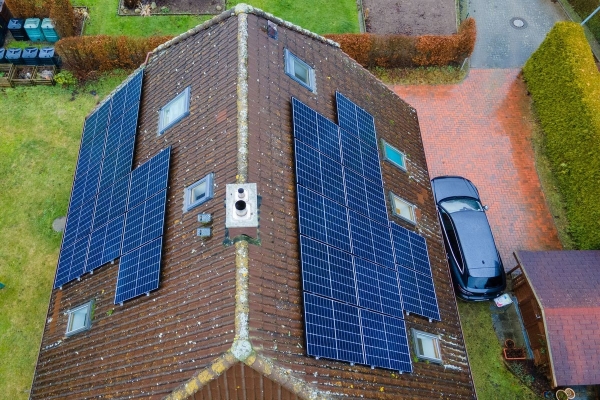One year ago, on the cusp of Russia’s invasion of Ukraine, it seemed unimaginable that renewable energy in Europe could overtake electricity from oil and gas.
But not even a year later, it did. By the end of 2022, wind and solar combined overtook natural gas in electricity generation. The latest data on Europe’s renewable transition tells a remarkably upbeat story about the hard things countries can accomplish on climate change with enough political will.
Before the Russia-Ukraine war, 40 percent of natural gas and 27 percent of oil imports to Europe came from Russia, and Europe lacked pipelines and terminals in locations that could distribute gas from other parts of the world like the US. After sanctions on Russian oil and gas, instability led to high price shocks, fuel shortages, and a brief uptick in coal usage this winter.
But the worst fears did not materialize, either. The risk was that the EU would fill the gap left by Russian sanctions with coal, the most polluting fossil fuel. And while coal did briefly make a comeback — fossil fuel generation rose last year by 3 percent — it was a temporary increase.
Meanwhile, solar energy especially is on an “unstoppable” track of growth, explained Dave Jones, an analyst at the global energy think tank Ember. Solar capacity in Europe doubled since 2018, and is on track to triple in the next four years.
:no_upscale()/cdn.vox-cdn.com/uploads/chorus_asset/file/24424140/Screen_Shot_2023_02_10_at_2.55.39_PM.png)
Two things happened in 2022 that made renewables outcompete both coal and gas: Renewable technology is getting reliably cheaper while its competitors are getting more expensive.
Oil, gas, and coal are commodities, and as physical goods, their prices are dictated by volatility in markets. Oil price shocks occur once every few years. But solar and wind prices depend on technology getting better, which follows a much more predictable curve as it gets cheaper and more advanced.
As my colleague Umair Irfan has written, while the technology still has room for improvement, “what’s needed is not so much a better wind turbine or solar panel as much as broader policy changes that encourage more widespread adoption.”
The Russia-Ukraine war turned out to be the crisis to propel that adoption.
European households and businesses turned to rooftop solar last year as they worried about skyrocketing electricity costs. They added three times as many gigawatts in 2022 as in the year before.
As the chart below shows, Europe could be on track to triple that again in the next four years:
:no_upscale()/cdn.vox-cdn.com/uploads/chorus_asset/file/24437300/Screen_Shot_2023_02_16_at_9.45.06_AM.png)
Energy efficiency also had its moment. Simply using less energy is one of the more underrated climate and cost solutions; it’s effective, but difficult to implement on a big scale. Voluntary measures played a role in Europeans’ slashing electricity usage 20 percent. So did some large-scale efforts by governments and corporations: Countries turned down the heat in public buildings, France turned off the lights early on the Eiffel Tower, and public education campaigns encouraged people to use electricity outside peak hours.
But better technology can also help us slash energy usage. Heat pumps require less energy than traditional furnaces and boilers. Heat pumps were already on the rise in Europe before the Russian invasion of Ukraine, and sales soared in 2022, doubling in countries like Poland, Italy, Austria, and the Netherlands.
This year is likely to see the beginning of the end of natural gas in Europe. Ember expects fossil fuel generation to fall by 20 percent, as hydro and nuclear rebound along with rising solar and wind. Gas will fall the fastest because it’s now the most expensive fuel in Europe, due to the sanctions on Russia.
Europe shows we can do hard things
The US is behind Europe’s renewable trajectory, but not that far behind.
In the EU, wind and solar combined to produce more energy than coal in 2019; the US is poised to hit that milestone in the next year or two, according to the US Energy Information Administration. In 2022, natural gas accounted for 38 percent of US electricity generation, and coal for 23 percent, compared to wind and solar together at 14 percent of electricity. (In Texas, wind has already overtaken coal).
And while heat pumps have taken off in Europe, federal incentives are just now kicking in to encourage their adoption in the US.
The 2022 data carries lessons from the US — and also a warning not to overcorrect with new fossil fuel infrastructure.
In response to the crisis, some EU and US politicians called for a ramping up of fossil fuel infrastructure to remake how natural gas is shipped around the world. Instead of Europe importing gas via pipeline from Russia, the US (now the largest exporter of gas in the world) would condense it into its liquefied form to ship across the ocean. This would require a vast amount of infrastructure, investment, and permitting.
Germany has managed to build the fastest version of this, offshore floating terminals that can accept liquefied natural gas, in a single year. Julian Popov, a European Climate Foundation fellow, explained that the EU has plenty of excess capacity to import gas, but it’s just in the wrong places to ease the congestion. Remaking the EU’s entire fossil fuel system to accept US gas instead of Russian will take years to get up and running, longer if governments are doing their due diligence in reviewing permitting.
“Gas generation and gas use is becoming more uncompetitive compared to renewables,” Popov said in a recent press call. Gas companies building infrastructure might find that by the time it’s complete, it will be too expensive to compete with renewables.
In other words, more gas infrastructure won’t help in the near term, and it does more damage than good in the longer term. If the world is serious about limiting climate change, industrialized countries already have all the fossil fuel infrastructure we can afford.
“The facilities being built and the pipelines and the tankers are being built on the expectation of a 20- to 30-year life,” said Mark Campanale, head of the UK think tank Carbon Tracker. “What happens if they’ve only got 10 years? The investors will never see the return that they thought they were gonna get.”
The EU has plenty of other challenges to sort out that don’t involve building redundant fossil fuel infrastructure. One is cracking harder renewable challenges, like scaling up mass storage for all the rooftop solar being installed. Another is replacing the millions of gas boilers, furnaces, and stoves in people’s homes that run on gas with heat pump and induction alternatives that use less electricity overall.
But the speed of the change over the last year suggests that these challenges can be overcome. If there’s one lesson Campanale suggests taking from the last year in Europe, it’s that “the fossil fuel system is going to go. The days of burning things to heat our home or to power to go from A to B are over.”






